Do you have a question about the Roland V-Drums TD-3 and is the answer not in the manual?
Explains the meaning of WARNING and CAUTION symbols used in the manual.
Explains various warning, prohibition, and mandatory action symbols.
Lists essential safety instructions to follow during operation and handling.
Notes on connecting and using the power supply to prevent issues.
Guidance on where to place the unit to avoid interference and damage.
Instructions for cleaning and upkeep of the unit to prevent damage.
Information regarding unit repairs and the importance of backing up data.
Further important advice for operating the unit safely and effectively.
Details and functions of the buttons and display on the top panel.
Identifies and explains the ports and jacks on the rear of the unit.
Describes the connectors and slots located on the side panel.
Step-by-step guide for attaching the unit to a drum stand.
Instructions for wiring the drum pads, pedals, and triggers to the unit.
Guidance on connecting external amplifiers, speakers, and headphones.
Steps for safely turning the unit and connected devices on and off.
Overview of trigger inputs and how pads/cymbals are played.
How to play head and rim sounds on snare and hi-hat pads.
How to perform a cross stick on the snare pad.
Techniques for playing cymbal edges and choking cymbal sounds.
Overview of what constitutes a drum kit's settings, including sounds and parameters.
How to choose between the 32 preset drum kits available on the unit.
Assigning individual sounds (instruments) to pads and their rims.
Controlling volume and stereo position for each instrument assigned to a pad.
Choosing from 15 pre-programmed ambience effects for the kit.
How to copy settings from one drum kit to another.
Turning the click sound on and off using the CLICK button.
Setting the click's tempo (Beats Per Minute) using the TEMPO button.
Adjusting the beat and measure structure for the metronome click.
Choosing different rhythmic patterns for the metronome click.
Selecting the sound for the metronome click from various options.
Setting the volume for the metronome click.
How to select and start a practice exercise within COACH mode.
Using rhythmic exercises for warm-up and learning note values.
Measuring performance against the metronome for timing accuracy.
Developing internal tempo sense with quiet count exercises.
Improving timing accuracy over multiple measures.
Exercises for building stamina with gradual tempo changes.
Exercises for building stamina with step-wise tempo changes.
Using voice count-ins and visual measure counters in practice.
Customizing how hard you need to hit a pad for a response.
Preventing accidental triggering from adjacent pads.
Setting the volume for the closed hi-hat pedal position.
Overview of compatible pads and trigger input functions.
How to set the polarity switch for certain pads.
How to play sounds assigned to pad heads and rims.
How to play the cross stick sound on the snare pad.
How to play different parts of a cymbal (bow, edge, bell).
How to mute cymbal sounds by squeezing the pad.
Example configuration for a 3-tom, 3-cymbal setup.
Example configuration for a 2-tom, 4-cymbal setup.
Setting the correct trigger type for each connected pad.
Fine-tuning how hard you hit a pad to trigger a sound.
Preventing false triggers from vibrations by setting minimum force levels.
Controlling how playing force affects the sound volume.
Optimizing trigger signal detection for consistent volume.
Preventing false triggers from signal attenuation.
Reducing accidental triggering between adjacent pads.
Preventing double triggers from pad bounce-back.
Adjusting sensitivity for rim shot sounds.
Adjusting volume based on rim/edge playing velocity.
Basic explanation of MIDI and its use with the TD-3.
Description of the MIDI IN and OUT ports and their functions.
Assigning MIDI note numbers to each pad for custom control.
Using TD-3 pads to control external MIDI sound modules.
Configuring the TD-3 to use as a MIDI controller.
Saving TD-3 settings to an external MIDI sequencer.
Restoring saved data from a sequencer to the TD-3.
Details on MIDI channels, program changes, and hi-hat control.
Playing external sound modules using the TD-3.
Connecting keyboards or pads to use the TD-3 as a sound source.
Setting up to record TD-3 pad performances to a sequencer.
Diagnosing and resolving problems with sound output.
Troubleshooting issues related to pad response and triggering.
Resolving problems with the metronome sound.
Resolving low volume or no sound from the MIX IN jack.
Addressing issues where drum kits don't sound as intended.
Troubleshooting sound distortion in headphones or output.
Resolving issues when saving or loading data via MIDI.
Handling memory corruption or internal system problems.
Troubleshooting breaks in communication with external MIDI devices.
List of available sounds for the metronome click.
Explains the meaning of WARNING and CAUTION symbols used in the manual.
Explains various warning, prohibition, and mandatory action symbols.
Lists essential safety instructions to follow during operation and handling.
Notes on connecting and using the power supply to prevent issues.
Guidance on where to place the unit to avoid interference and damage.
Instructions for cleaning and upkeep of the unit to prevent damage.
Information regarding unit repairs and the importance of backing up data.
Further important advice for operating the unit safely and effectively.
Details and functions of the buttons and display on the top panel.
Identifies and explains the ports and jacks on the rear of the unit.
Describes the connectors and slots located on the side panel.
Step-by-step guide for attaching the unit to a drum stand.
Instructions for wiring the drum pads, pedals, and triggers to the unit.
Guidance on connecting external amplifiers, speakers, and headphones.
Steps for safely turning the unit and connected devices on and off.
Overview of trigger inputs and how pads/cymbals are played.
How to play head and rim sounds on snare and hi-hat pads.
How to perform a cross stick on the snare pad.
Techniques for playing cymbal edges and choking cymbal sounds.
Overview of what constitutes a drum kit's settings, including sounds and parameters.
How to choose between the 32 preset drum kits available on the unit.
Assigning individual sounds (instruments) to pads and their rims.
Controlling volume and stereo position for each instrument assigned to a pad.
Choosing from 15 pre-programmed ambience effects for the kit.
How to copy settings from one drum kit to another.
Turning the click sound on and off using the CLICK button.
Setting the click's tempo (Beats Per Minute) using the TEMPO button.
Adjusting the beat and measure structure for the metronome click.
Choosing different rhythmic patterns for the metronome click.
Selecting the sound for the metronome click from various options.
Setting the volume for the metronome click.
How to select and start a practice exercise within COACH mode.
Using rhythmic exercises for warm-up and learning note values.
Measuring performance against the metronome for timing accuracy.
Developing internal tempo sense with quiet count exercises.
Improving timing accuracy over multiple measures.
Exercises for building stamina with gradual tempo changes.
Exercises for building stamina with step-wise tempo changes.
Using voice count-ins and visual measure counters in practice.
Customizing how hard you need to hit a pad for a response.
Preventing accidental triggering from adjacent pads.
Setting the volume for the closed hi-hat pedal position.
Overview of compatible pads and trigger input functions.
How to set the polarity switch for certain pads.
How to play sounds assigned to pad heads and rims.
How to play the cross stick sound on the snare pad.
How to play different parts of a cymbal (bow, edge, bell).
How to mute cymbal sounds by squeezing the pad.
Example configuration for a 3-tom, 3-cymbal setup.
Example configuration for a 2-tom, 4-cymbal setup.
Setting the correct trigger type for each connected pad.
Fine-tuning how hard you hit a pad to trigger a sound.
Preventing false triggers from vibrations by setting minimum force levels.
Controlling how playing force affects the sound volume.
Optimizing trigger signal detection for consistent volume.
Preventing false triggers from signal attenuation.
Reducing accidental triggering between adjacent pads.
Preventing double triggers from pad bounce-back.
Adjusting sensitivity for rim shot sounds.
Adjusting volume based on rim/edge playing velocity.
Basic explanation of MIDI and its use with the TD-3.
Description of the MIDI IN and OUT ports and their functions.
Assigning MIDI note numbers to each pad for custom control.
Using TD-3 pads to control external MIDI sound modules.
Configuring the TD-3 to use as a MIDI controller.
Saving TD-3 settings to an external MIDI sequencer.
Restoring saved data from a sequencer to the TD-3.
Details on MIDI channels, program changes, and hi-hat control.
Playing external sound modules using the TD-3.
Connecting keyboards or pads to use the TD-3 as a sound source.
Setting up to record TD-3 pad performances to a sequencer.
Diagnosing and resolving problems with sound output.
Troubleshooting issues related to pad response and triggering.
Resolving problems with the metronome sound.
Resolving low volume or no sound from the MIX IN jack.
Addressing issues where drum kits don't sound as intended.
Troubleshooting sound distortion in headphones or output.
Resolving issues when saving or loading data via MIDI.
Handling memory corruption or internal system problems.
Troubleshooting breaks in communication with external MIDI devices.
List of available sounds for the metronome click.
| Type | Electronic Drum Kit |
|---|---|
| Sound Module | TD-3 |
| Polyphony | 32 voices |
| Effects | Reverb |
| Display | LCD |
| Inputs | Trigger inputs (for pads) |
| Outputs | Stereo outputs, headphone output |
| Inputs/Outputs | Trigger Input connector (DB-25 type), Output Jacks (L/MONO, R): 1/4" phone type, Phones Jack (Stereo 1/4" phone type), MIDI OUT connector |
| Power Supply | AC adapter |
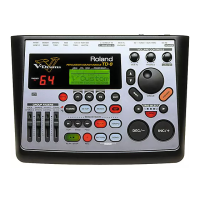
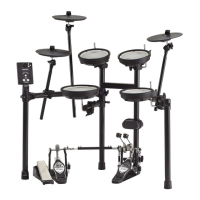
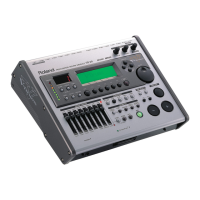
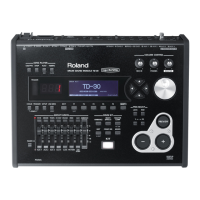
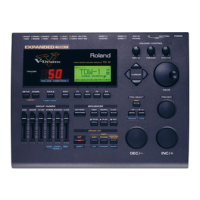
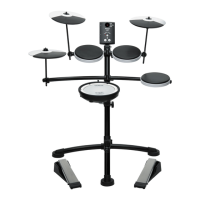
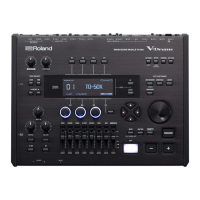
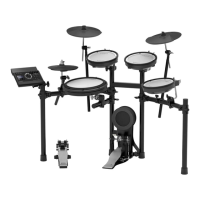
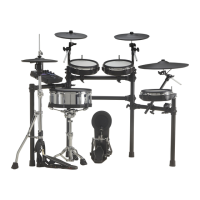
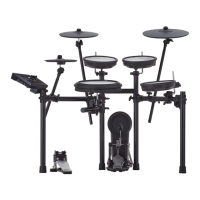
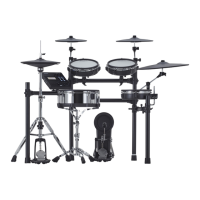
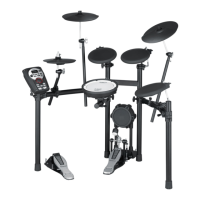
